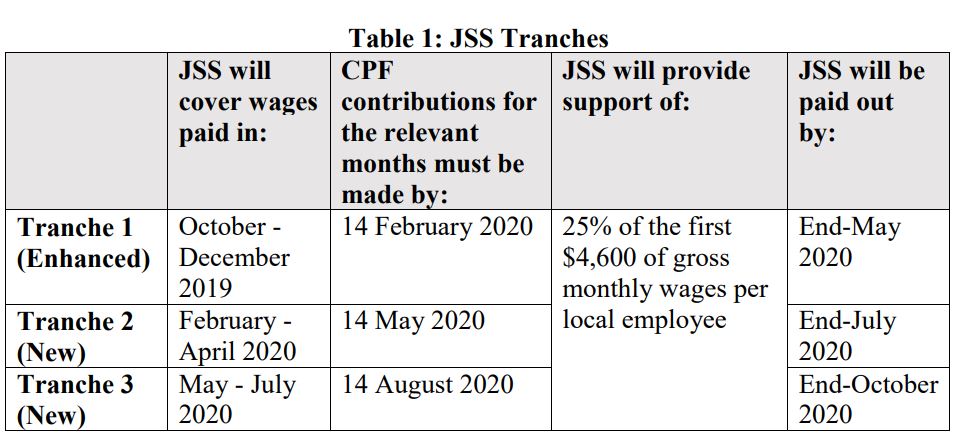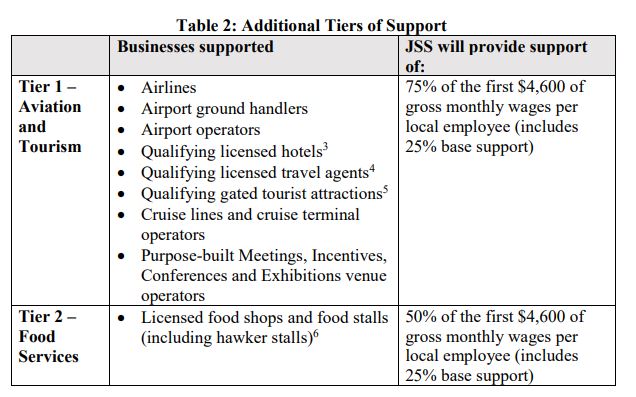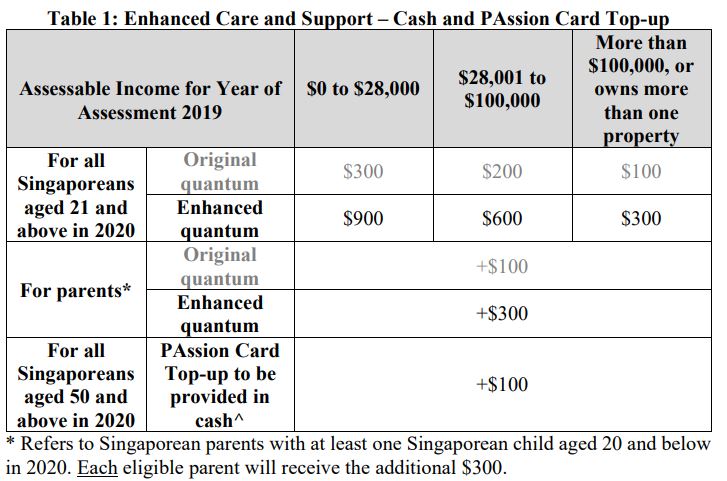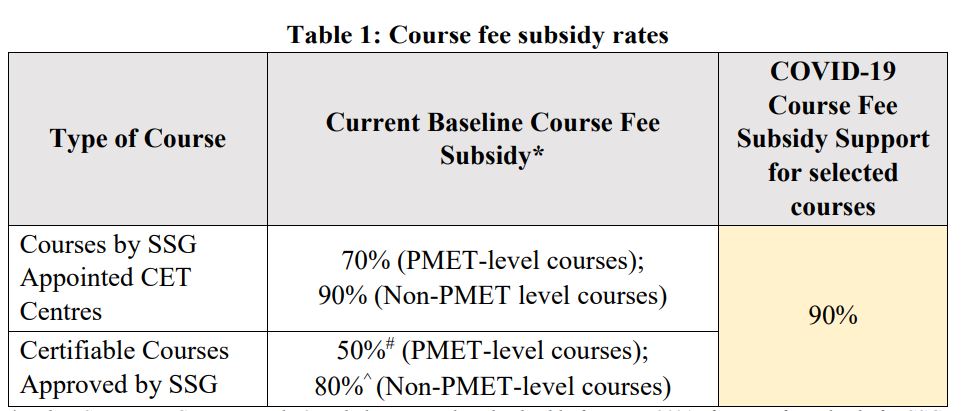Jobs Support Scheme ("JSS")
Current Treatment
Employers will receive an 8% cash grant on the gross monthly wages of each local employee (applicable to Singapore Citizens and Permanent Residents only) for the months of October 2019 to December 2019, subject to a monthly wage cap of $3,600 per employee.
Employers do not need to apply for the JSS. The grant will be computed based on CPF contribution data.
Employers can expect to receive the JSS payment from the Inland Revenue Authority of Singapore (IRAS) by 31 July 2020.
Wages paid to business owners will not be eligible for the grant.
New Treatment
The cash grant will be increased to 50% for food and service industry, 75% for the aviation and tourism sectors, and 25% for rest of the industry.
The monthly qualifying wage ceiling is increased from S$3,600 to S$4,600.
The Jobs Support Scheme is extended for another two quarters, till the end of 2020.
Employers will receive a total of three tranches of payouts, in May, July, and October this year.


The gated attraction must have more than 30% visitorship from tourists, and be classified under one of the following SSIC codes:
- SSIC 91021: Museums;
- SSIC 91022: Art galleries (excluding retail);
- SSIC 91029: Preservation of historical sites, buildings, artefacts and paintings, cultural villages and other related activities n.e.c.;
- SSIC 91030: Botanical and zoological gardens and nature reserve activities;
- SSIC 93201: Amusement theme parks;
- SSIC 93209: Other amusement and recreation activities n.e.c. (including recreation parks/beaches and recreational fishing).
- SSIC 56: Food and Beverage Service Activities;
- SSIC 68104: Letting and operating of self-owned or leased food courts, coffee shops and eating houses (with mainly rental income).
Self-Employed Person Income Relief Scheme ("SIRS")
Current Treatment
Not applicable.
New Treatment
Eligible self-employed persons will receive S$1,000 a month for nine months.
*Will be updated when MOM release details.
Self-Employed Person Training Support Scheme
Current Treatment
Announced on 3 March 2020, it gives all freelancers a training allowance of S$7.50 an hour when they attend courses under the SkillsFuture Series, as well as selected sector-specific training programmes.
New Treatment
The training allowance is increased to S$10.00 an hour with effect from 1 May 2020.
Workfare Income Supplement Scheme ("WIS")
Current Treatment
You will qualify for WIS if you:
- are a Singapore Citizen;
- are 35 years old or above on 31 December of the work year (all persons with disabilities would qualify for WIS); and
- earn a gross monthly income of not more than S$2,300 for the month worked.
You will receive additional 20% of total annual WIS payments received for work done in 2019, with a minimum payment of $100. The highest WSP payout would have been S$720.
New Treatment
The Workfare Special Payment is increased to S$3,000, which will be paid over two equal payments of S$1,500 each, in July and October 2020.
COVID-19 Support Grant
Current Treatment
Not applicable.
New Treatment
The scheme eligibility criteria are as follows:
- Singapore Citizens or Permanent Residents, aged 16 years and above,
- who are presently unemployed due to retrenchment or contract termination as a result of the economic impact of the COVID-19 situation, and meet all of the following:
- Had a monthly household income of not more than $10,000, or per capita household income not more than $3,100 per month prior to unemployment;
- Lives in a property with an annual value of not more than $21,000; and
- Not currently receiving ComCare Short-to-Medium Term Assistance(SMTA) or ComCare Interim Assistance.
- The applicant must have been employed as a full-time, or part-time permanent, or contract staff prior to unemployment.
Successful applicants will receive a monthly cash grant of S$800, for three months.
The scheme will be open for application from May 2020 to September 2020.
Individuals who are eligible may submit their application at their nearest Social Service Office,
Care and Support Package
Current Treatment
All Singaporeans aged 21 years and above in 2020 will receive a one-off Care and Support – Cash payout of S$300, S$200 or S$100, depending on their income.
Those who own more than one property will receive S$100, regardless of their income.
Parents, with one or more Singaporean children aged 20 years and below in 2020, will each receive an additional $100 in cash.
New Treatment
The one-off Care and Support – Cash payout that was announced at Budget 2020 will be tripled for all Singaporeans aged 21 and above in 2020.
Each eligible citizen will receive S$900, S$600, or S$300, depending on their income.
Those who own more than one property will receive S$300, regardless of their income.
Parents, with at least one Singaporean child aged 20 and below in 2020, will each receive an additional S$300 in cash.

Deferment of Income Tax Payments for Companies
Current Treatment
Tax payable on first ECI e-Filed within
- 1 months from year end: 12 months
- 2 months from year end: 10 months
- 3 months from year end: 8 months
- After 3 months from year end: No installments allowed
New Treatment
All companies with CIT payments due in the months of April, May, and June 2020 will be granted an automatic three-month deferment of these payments.
The CIT payments deferred from April, May, and June 2020 will instead be collected in July, August, and September 2020 respectively.
No application is required.
Deferment of Personal Income Tax (PIT) Payments for Self-Employed Persons (SEPs)
Current Treatment
Not applicable.
New Treatment
All SEPs are to file their personal income tax (PIT) returns for YA2020 by 18 April 2020. SEPs will be granted an automatic three-month deferment of their PIT payments due in the months of May, June, and July 2020. The PIT payments deferred from May, June, and July 2020 will instead be collected in August, September, and October 2020 respectively.
Rental Waivers for Tenants in Government-Owned / Managed Non-Residential Facilities
Current Treatment
Stallholders at hawker centres and markets managed by the National Environment Agency (NEA) will be given one month’s worth of rental waiver, with a minimum waiver of $200.
Commercial tenants in other government-owned or managed facilities will be provided with half a month’s worth of rental waiver.
These include facilities owned or managed by agencies such as the Housing Board, People’s Association, National Parks Board, JTC, Urban Redevelopment Authority, Singapore Tourism Board and Sentosa Development Corporation.
New Treatment
Stallholders at hawker centres and markets managed by the National Environment Agency (NEA) will be given three months’ worth of rental waiver, with a minimum waiver of $200.
Commercial tenants in other government-owned or managed facilities will be provided with two months’ worth of rental waivers.
Other Non-Residential Tenants. Government agencies such as JTC, SLA, HDB, URA, BCA, NParks, and PA will provide half a month’s worth of rental waiver to eligible tenants of other non-residential premises who do not pay Property Tax. Eligible tenants/lessees may include those in premises used for
industrial or agricultural purpose, or as an office, a business or science park, or a petrol station.
Enhanced Property Tax Rebate for Non-Residential Properties
Current Treatment
For the tourism sector:
- Property Tax Rebate of 30% for the year 2020, for the accommodation and function room components of licensed hotels and serviced apartments, and prescribed Meetings, Incentives, Conventions, and Exhibitions (MICE) venues.
- International cruise and regional ferry terminals will receive a 15% Property Tax Rebate, and
- the Integrated Resorts will receive a 10% Property Tax Rebate.
For the aviation sector:
- 15% Property Tax Rebate for Changi Airport
New Treatment
For the tourism sector:
- Property Tax Rebate of 100% for the year 2020, for the accommodation and function room components of licensed hotels and serviced apartments, and prescribed Meetings, Incentives, Conventions, and Exhibitions (MICE) venues.
- International cruise and regional ferry terminals will receive a 100% Property Tax Rebate, and
- the Integrated Resorts will receive a 60% Property Tax Rebate.
For the aviation sector:
- 100% Property Tax Rebate for Changi Airport
For other non-residential properties:
- 30% Property Tax Rebate
Enterprise Development Grant (EDG)
The Enterprise Development Grant (EDG) provides supports projects under 3 categories:
Core Capabilities
Projects under Core Capabilities help businesses prepare for growth and transformation by strengthening their business foundations.
Productivity
Projects under Innovation and Productivity support companies that explore new areas of growth, or look for ways to enhance efficiency.
Market Access
Projects under Market Access support Singapore companies that are willing and ready to venture overseas.
Current Treatment
Currently, the maximum support level is 70%, until 31 March 2023.
New Treatment
From 1 April 2020 to 31 December 2020, the support level will be raised from up to 70% to up to 80%. For enterprises that are most severely impacted by COVID19, the maximum support level will be further raised to 90% on a case-by-case basis.
Productivity Solutions Grant (PSG)
The PSG provides support to enterprises in their transformation journey through funding support for the adoption of off-the-shelf productivity solutions and equipment that have been pre-approved by the Government.
Current Treatment
Currently, the maximum support level is 70%, until 31 March 2023.
New Treatment
From 1 April 2020 to 31 December 2020, the maximum support level will be raised from 70% to 80%.
SMEs Go Digital
The SMEs Go Digital programme aims to help SMEs use digital technologies and build stronger digital capabilities to seize growth opportunities in the digital economy.
Current Treatment
Not applicable.
New Treatment
From 1 April 2020 to 31 December 2020, the scope of pre-approved digital solutions will be expanded to cover:
- Online collaboration tools;
- Virtual meeting and telephony tools;
- Queue management systems; and
- Temperature screening solutions.
The list of digital solutions fro PSG can be found on the Tech Depot
(www.smeportal.sg/content/tech-depot/en/home.html).
SMEs that are looking for visitor registration and contact tracing tools can access free trials provided by the tech industry
Stabilisation and Support Package (SSP) - Course fee subsidy
Current Treatment
SkillsFuture Singapore (SSG) provides course fee subsidies (70% to 90%) and absentee payroll for a wide range of approved courses to support employers in sending their employees for training.
New Treatment
Under the Stabilisation and Support Package (SSP), SSG is providing 90% course fee subsidies and absentee payroll (AP) rates for employers in sectors directly affected by the COVID-19 outbreak (i.e. air transport, tourism, retail, and food services), when they sponsor their workers for eligible courses.
These enhancements will last for three months.


SG Together Enhancing Enterprise Resilience (STEER)
STEER supports funds set up by the Trade Associations and Chambers (TACs) or industry groupings, with the aim of helping businesses tide over the challenges arising from COVID-19, and to push on with transformation efforts in preparation for economic recovery.
Current Treatmement
Under the programme, Enterprise Singapore matches S$1 for every S$4 raised by such industry-led funds, up to S$1 million per fund.
New Treatment
From 1 April 2020, Enterprise Singapore will match S$1 for every S$2 raised by such industry-led funds, up to S$1 million per fund.
E-invoicing Registration Grant
Current Treatment
Not applicable.
New Treatment
Businesses registered on the nationwide e-invoicing network on or before 31 December 2020 will receive a one-time grant of S$200. Businesses can register through more than 50 Peppol-ready accounting and ERP solutions. Once registered on the nationwide e-invoicing network, businesses will be able to send and receive e-invoices through the network.
Businesses incorporated on or before 25 March 2020 and registered on the network on or before 31 December 2020 will automatically receive their grant via PayNow Corporate.
There is no need to apply for the grant.
Advanced Digital Solutions
IMDA and Enterprise Singapore will provide up to 80% funding support for enterprises to adopt advanced digital solutions from 1 May 2020 to 31 December 2020.
Current Treatment
Not applicable.
New Treatment
Examples include:
- Advanced security and facilities management systems for buildings – cluster guarding, digital concierges, sensors and analytics for energy management and predictive maintenance, smart toilet systems, and mobile robots for security and/or cleaning. These solutions will help enterprises balance the need to minimise physical contact among staff, with the increased demand for security, cleaning and maintenance. It will also help to integrate security,
cleaning and maintenance for more seamless facilities management. - Integrated Business-to-Business (B2B) systems to facilitate end-to-end
transactions between buyers and sellers. These would help enterprises transit from manual/paper transactions to electronic transactions by covering interlinked transactions such as e-procurement, e-invoicing, e-payments, and inventory management.
Enterprise Financing Scheme – SME Working Capital Loan
Current Treatment
Maximum loan quantum: S$600,000
Maximum repayment period: 5 years
Government’s risk-share: 80%.
Interest rate: Subject to assessment by Participating Financial Institutions (PFIs)
Principal Payment Deferment: Not Applicable
New Treatment
Maximum loan quantum: S$1,000,000
Maximum repayment
period: 5 years
Government’s risk-share: 80%.
Interest rate: Subject to assessment by Participating Financial Institutions (PFIs)
Principal Payment Deferment: SMEs may request for deferment of principal repayment for 1 year, subject to assessment by PFIs
Enterprise Financing Scheme – Trade Loan
The Enterprise Financing Scheme – Trade Loan supports Singapore-based enterprises’ trade financing needs, which include the financing of short-term import, export, and guarantee needs.
Current Treatment
Maximum loan quantum: S$5,000,000 per borrower group,
Maximum repayment
period: 1 year
Government’s risk-share: 70%.
Interest rate: Subject to assessment by Participating Financial Institutions (PFIs)
New Treatment
Maximum loan quantum: $10,000,000 per borrower group,
Maximum repayment
period: 1 year
Government’s risk-share: 80%.
Interest rate: Subject to assessment by Participating Financial Institutions (PFIs)
Loan Insurance Scheme (LIS)
The Loan Insurance Scheme helps SMEs secure short-term trade loans by having commercial insurers co-share loan default with Participating Financial Institutions. A portion of the insurance premium paid by SMEs to insurers is supported by the Government.
Current Treatment
Maximum loan quantum insured: Subject to assessment by Commercial Insurers and Participating Financial Institutions
Maximum insured period: 1 year
Government’s subsidy on
insurance premium: 70%
New Treatment
Maximum loan quantum insured: Subject to assessment by Commercial Insurers and Participating Financial Institutions
Maximum insured period: 1 year
Government’s subsidy on
insurance premium: 80%
Temporary Bridging Loan Programme (TBLP)
The Loan Insurance Scheme helps SMEs secure short-term trade loans by having commercial insurers co-share loan default with Participating Financial Institutions. A portion of the insurance premium paid by SMEs to insurers is supported by the Government.
Current Treatment
Sector Coverage: Tourism enterprises
Maximum loan quantum: S$1,000,000 previously
Maximum repayment
period: 5 years
Government’s risk-share: 80%
Interest rate: Capped at 5% per annum
Principal Payment Deferment: Not applicable
New Treatment
Sector Coverage: All sectors
Maximum loan quantum: S$5,000,000 per borrower group
Maximum repayment
period: 5 years
Government’s risk-share: 80%
Interest rate: Capped at 5% per annum
Principal Payment Deferment: Enterprises may request for deferment of principal repayment for 1 year, subject to assessment by PFIs
Government fees and charges
Current Treatment
Not applicable.
New Treatment
All government fees and charges are freeze. i.e. No incremental of fees and charges.
All agencies will continue to collect fees and charges.
Temporary Relief Fund
Current Treatment
Not applicable.
New Treatment
Some families may require help urgently may apply for Temporary Relief Fund in the month of April, to provide them with immediate financial assistance.
This will be available at Social Service Offices and Community Centres.
SGUnited Traineeships programme
Current Treatment
Not applicable.
New Treatment
Workforce Singapore (WSG) will co-share manpower costs with enterprises that offer traineeships targeted at local first-time jobseekers this year.
*Will be updated when MOM release details.
